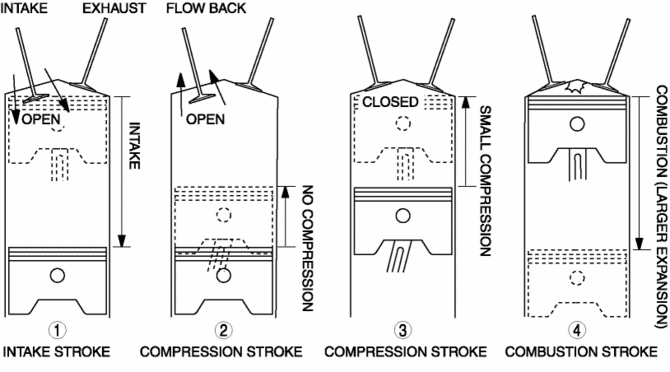Mazda CX-5 Service & Repair Manual: Miller Cycle Engine
Outline
-
The Miller cycle engine is a high-efficiency engine which achieves high fuel economy performance by obtaining a high-expansion ratio.
-
The Miller cycle engine achieves a high-expansion ratio without increasing its effective compression ratio by retarding the intake air valve close timing.
Operation
1. Intake air is introduced into the cylinder.
2. The intake valve is kept open after the intake stroke is finished to force the air in the cylinder to flow back to the intake pipe.
3. The compression stroke starts from the position in which the intake valve is closed (small compression).
4. The air-fuel mixture is combusted and the piston is pushed down to BDC (large expansion).

 Mechanical
Mechanical
Outline
The sliding resistance*1 has been reduced by:
the adoption of a rocker arm (built into needle roller bearing)
reducing load on the valve spring
narrow ...
 Non Return Valve Inspection
Non Return Valve Inspection
WARNING:
Fuel is very flammable liquid. If fuel spills or leaks from the pressurized
fuel system, it will cause serious injury or death and facility breakage. Fuel
can also irritate skin ...
Other materials:
Discharge Headlight Control Module
Purpose
Converts DC voltage from the battery to AC voltage and outputs the stabilized
voltage to the discharge headlight.
Function
The discharge headlight control module controls the voltage from the battery
to illuminate the discharge headlight.
The discharge headl ...
Fuel Filler Pipe Removal/Installation
WARNING:
Fuel is very flammable liquid. If fuel spills or leaks from the pressurized
fuel system, it will cause serious injury or death and facility breakage. Fuel
can also irritate skin and eyes. To prevent this, always complete the “Fuel
Line Safety Procedure”, while referring ...
Planetary Gear [Fw6 A EL, Fw6 Ax EL]
Purpose/Function
The planetary gear is a mechanism which shifts the drive force from the engine.
The planetary gear consists of multiple gears which rotate individually while
revolving. By controlling the individual rotation and revolving of the gears,
the transaxle performs gear shi ...
